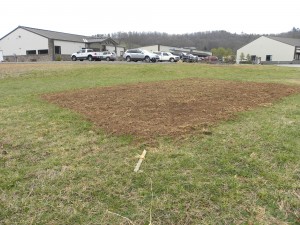We are growing a garden outside our clinic.
I’ll admit it sounds a little unconventional. Maybe you’re wondering if we have so little to do all day that we’re taking on this extra project to fill the hours (not it). Maybe you’re thinking we’re going to use our patients as free labor to take care of the garden (not it…completely).
There’s actually a few reasons why we’re doing it. One, it’s really an ideal space for a garden – plenty of sunlight, good drainage, and enough traffic that we’ll be guilted into keeping it looking pretty. Two, and this is personal – my family and I love the fresh vegetables that come from a garden, but our house is in the woods and after 3 years of failure, we’ve determined our soil, lack of sunlight, and array of wild animals traipsing through our yard is not going to yield a successful harvest. Three, many of our staff enjoy gardening and I hope this will encourage them to push away from their desks during lunch and give them a reason to go outside (because you never have enough supervisors on hand to offer advice, right?)
But the main reason we decided to create a garden in a professional setting is to offer an innovative, real-world application to help our patients. Many of you are avid gardeners and spend a lot of hours digging, weeding, bending over, hauling rocks, shoveling, raking, hoeing, watering, fertilizing, staking…which means your bodies spend many hours bending in weird positions, working in repetitive motions, and straining muscles, ligaments and discs. Nantahala Physical Therapy wants to help you be successful not only in the food you produce, but how you feel during and after your gardening workout.
If you become a patient and gardening is something you enjoy, let your therapist know. We’ll spend some of your therapy time working outside, making sure you’re using proper body mechanics to avoid injuries. And who knows….maybe we’ll share a tomato or two.
Randy
p.s. A big thank you to Wesley Hirsch, a master gardener himself, who is helping us have a successful harvest.

